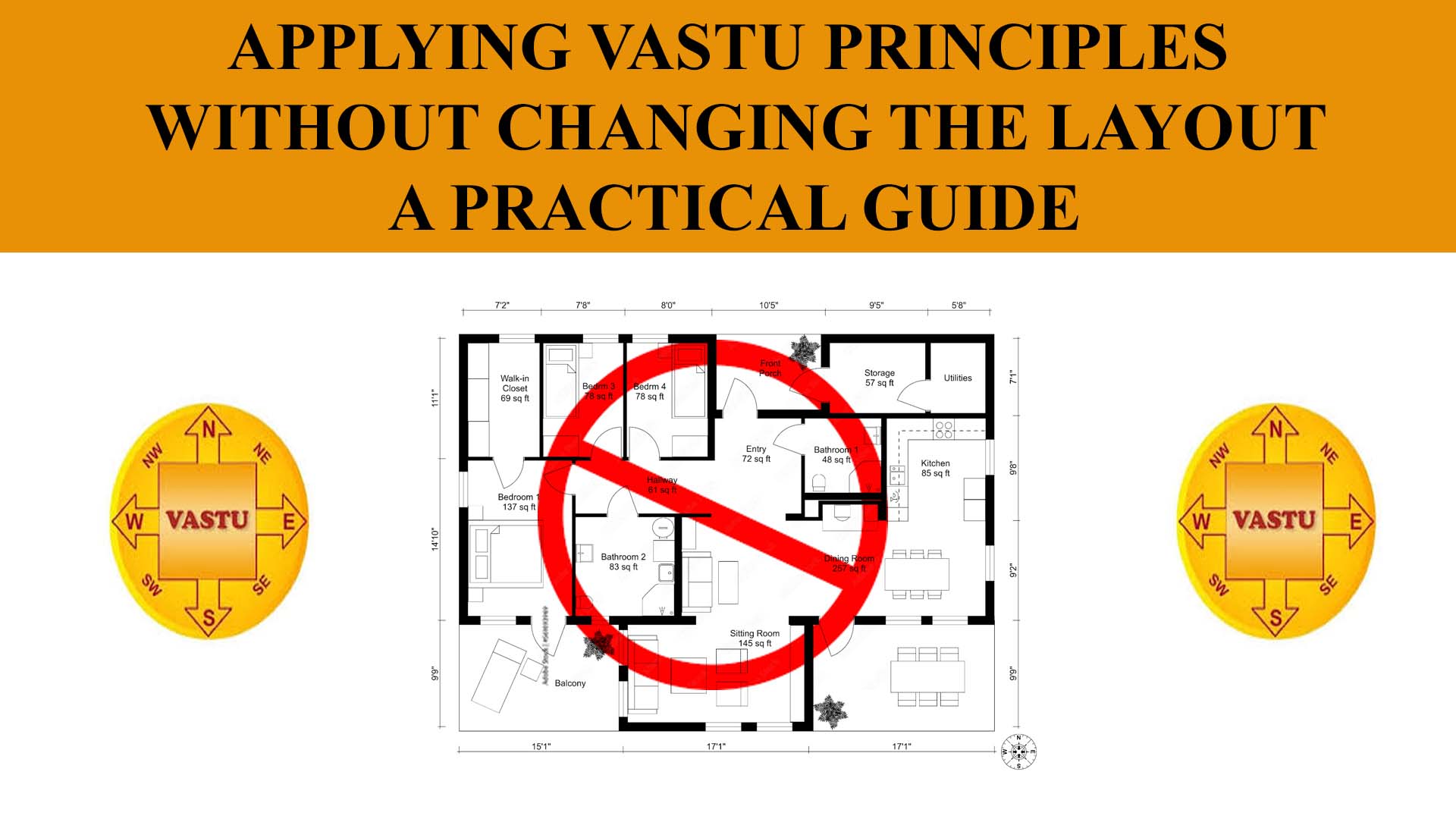
Applying Vastu Principles Without Changing the Layout: A Practical Guide
Vastu Shastra, an ancient Indian science of architecture and design, emphasizes the importance of creating harmonious living spaces to enhance the well-being of occupants. While an ideal application involves designing a space with Vastu principles from the ground up, there are ways to incorporate these principles even if you cannot alter the existing layout. In this blog post, we will explore various practical ways to apply Vastu principles within the constraints of an existing structure.
De-Clutter and Organize:
- Begin by decluttering your space. Remove unnecessary items and organize belongings to allow the free flow of energy (prana). A clutter-free environment promotes positive vibrations and a sense of order.
Balance the Elements:
- Identify the predominant elements in each room (earth, water, fire, air, and space). Introduce decor and colors that balance these elements. For example, use plants to represent the earth element or incorporate a water feature for the water element.
Correcting Imbalances with Symbols:
- Use Vastu symbols strategically. Place symbols like the Swastika or Om at key locations to counterbalance negative energies. These symbols are believed to bring positive vibrations and ward off negative influences.
Directional Enhancements:
- While you may not be able to change the cardinal directions of a room, you can enhance positive energies by placing objects in specific directions. For instance, position a mirror to reflect natural light from the north direction, symbolizing prosperity.
Color Psychology:
- Utilize color psychology to create a harmonious atmosphere. Choose colors based on their associations with the five elements. Earthy tones for stability, blue for calmness, and green for growth are examples of aligning colors with Vastu principles.
Furniture Placement:
- Rearrange furniture to ensure free movement and accessibility. Avoid placing furniture in the center of rooms, as it may obstruct energy flow. Position seating and beds against solid walls for support and stability.
Lighting Arrangements:
- Illuminate spaces appropriately to enhance positive energy. Use natural light wherever possible and incorporate warm artificial lighting. Ensure that dark corners are well-lit to dispel negativity.
Mirror Placement:
- Mirrors can be strategically placed to amplify positive energies. Reflecting a beautiful view or placing mirrors to expand the sense of space can contribute to a more positive atmosphere.
Sound and Aromatherapy:
- Integrate soothing sounds and aromas into your environment. Wind chimes, soft music, and pleasant scents can positively influence the energy in a space, creating a serene atmosphere.
Conclusion: Applying Vastu principles to an existing layout may require creativity and flexibility. While you may not be able to change the structural aspects, implementing these practical suggestions can contribute to a more harmonious and positive living environment. Remember that the key is to create a balanced and comfortable space that aligns with your well-being and the principles of Vastu Shastra.
Q&A:
Q: Can I apply Vastu principles to my apartment, or are these principles only for houses with specific architectural designs?
A: Vastu principles can be applied to apartments as well. While it's true that the ideal application starts from the design phase, you can still incorporate Vastu principles in your apartment by focusing on elements like decluttering, color choices, and furniture arrangement.
Q: I can't change the cardinal directions of my rooms. How can I enhance positive energies in a room that doesn't face an ideal direction?
A: While you can't alter the cardinal directions, you can enhance positive energies by strategically placing objects. For example, use mirrors to reflect natural light from a favorable direction or place symbols associated with prosperity in key locations.
Q: What are some Vastu symbols that can be used to counterbalance negative energies in a space?
A: Vastu symbols like the Swastika, Om, or even traditional religious symbols are believed to bring positive vibrations and counterbalance negative energies. You can place these symbols at specific locations in your home for their potential benefits.
Q: Can you provide more guidance on color choices based on Vastu principles?
A: Certainly! Vastu associates colors with the five elements. For example, earthy tones (browns and yellows) can represent the earth element, while blue can be associated with the water element. Choose colors that align with the desired energies for each room.
Q: How can I incorporate Vastu principles without major renovations or buying new furniture?
A: You can make subtle changes, such as rearranging existing furniture for better flow and accessibility. Introduce Vastu-friendly decor items, like symbols or artwork, and use color through accessories like cushions and curtains to align with Vastu principles without major expenses.
Q: Are there specific guidelines for incorporating Vastu principles in bedrooms?
A: Yes, for bedrooms, consider placing the bed against a solid wall for support and stability. Use calming colors like light blues and greens. Avoid clutter and maintain a soothing atmosphere with soft lighting. These adjustments can contribute to a more Vastu-friendly bedroom.
Q: Can I apply Vastu principles in a rental property, or is it only for homeowners?
A: Vastu principles can be applied in rental properties as well. Since many Vastu recommendations involve arranging and decorating existing spaces, you can make adjustments to create a more harmonious environment even if you don't own the property. Just be mindful of any restrictions imposed by your lease agreement.
Meta Title: ""
Meta Description:
Meta Keywords: Vastu principles, practical tips, layout adjustments, decluttering, balancing elements, Vastu symbols, color psychology, furniture arrangement, positive energies, harmonious living, apartment Vastu, room direction, Vastu-friendly decor, bedroom guidelines, rental properties.

Comments : (0)